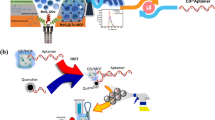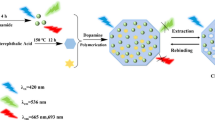Abstract
In our investigation, a smartphone-integrated ratiometric fluorescent sensing system with lanthanide-based infinite coordination polymers (Ce-GMP-DPA@Tb-DPA) as signal probe has been successfully constructed for sensitive and portable detection of water in organic solvents. The Ce-GMP-DPA presents blue luminescence which is suppressed once the Tb-DPA is integrated to form the complex of Ce-GMP-DPA@Tb-DPA. Due to the energy transfer from Ce to Tb, the as-formed Ce-GMP-DPA@Tb-DPA exhibits green fluorescence of Tb-DPA. The presence of water can decompose the Tb-DPA, which blocks energy transfer from Ce to Tb, resulting in the decrease of green emission of Tb-DPA and the recovery of blue emission of Ce-GMP-DPA. Therefore, a ratiometric fluorescence assay is established for quantitative water detection within a wide linear range from 0.2 to 90.0% in ethanol. The limit of detection (LOD) reaches as low as 0.16% in ethanol, 0.62% in THF, and 0.0076% in acetonitrile, respectively. Furthermore, a smartphone installed with Color Picker APP as signal reader and analyzer is designed to integrate with the detection assay. With white spirit as real sample, water can be on-site detected with high accuracy (RSD < 2.81%). The developed platform presents great potential for portable water detection in practical application with merits of low cost, easy carry, and simple operation.






Similar content being viewed by others
References
Kim WY, Shi H, Jung HS, Cho D, Verwilst P, Jin LY, et al. Coumarin-decorated schiff base hydrolysis as an efficient driving force for the fluorescence detection of water in organic solvents. Chem Commun. 2016;52:8675–8.
Kim TI, Kim Y. A water indicator strip: instantaneous fluorogenic detection of water in organic solvents, drugs, and foodstuffs. Anal Chem. 2017;89:3768–72.
Wang XY, Niu CG, Hu LY, Huang DW, Wu SQ, Zhang L, et al. A fluorescent ratiometric sensor based on covalent immobilization of chalcone derivative and porphyrin zinc for detecting water content in organic solvents. Sensors Actuators B Chem. 2017;243:1046–56.
Biradha K, Ramanan A, Vittal JJ. Coordination polymers versus metal-organic frameworks. Cryst Growth Des. 2009;9:2969–70.
Zhou Y, Zhang D, Xing W, Cuan J, Hu Y, Cao Y, et al. Ratiometric and turn-on luminescence detection of water in organic solvents using a responsive europium-organic framework. Anal Chem. 2019;91:4845–51.
Gamby J, Pailleret A, Clodic CB, Pradier CM, Tribollet B. In situ detection and characterization of potable water biofilms on materials by microscopic, spectroscopic and electrochemistry methods. Electrochim Acta. 2008;54:66–73.
Jung HS, Verwilst P, Kim WY, Kim JS. Fluorescent and colorimetric sensors for the detection of humidity or water content. Chem Soc Rev. 2016;45:1242–56.
Wang J, Wang J, Xiao W. Lignin-derived red-emitting carbon dots for colorimetric and sensitive fluorometric detection of water in organic solvents. Anal Methods. 2020;12:3218–24.
Men G, Chen C, Liang C. A novel cascade strategy with supramolecular and chemodosimetric methods for designing a fluorescent ratiometric detector hypersensitive to trace water. Analyst. 2015;140:5454–8.
Che L, Ye JW, Wang HP, Pan M, Yin SY, Wei ZW, et al. Ultrafast water sensing and thermal imaging by a metal-organic framework with switchable luminescence. Nat Commun. 2017;8:1–10.
Zhang Y, Liang C, Jiang S. A solvatochromic cyanostilbene derivative as an intensity and wavelength-based fluorescent sensor for water in organic solvents. New J Chem. 2017;41:8644–9.
Wang T, Li H. A red-emitting luminescent material capable of detecting low water content in organic solvents. Chem Eur J. 2016;22:12400–5.
Chao D, Lyu W, Liu Y. Solvent-dependent carbon dots and their applications in the detection of water in organic solvents. J Mater Chem C. 2018;6:7527–32.
Huang Y, Liu W, Feng H, Ye Y, Tang C, Ao H, et al. Luminescent nanoswitch based on organic-phase copper nanoclusters for sensitive detection of trace amount of water in organic solvents. Anal Chem. 2016;88:7429–34.
Cheng W, Xie Y, Yang Z. General strategy for in situ generation of a coumarin-Cu2+ complex for fluorescent water sensing. Anal Chem. 2019;91:5817–23.
Dong Y, Cai J, Fang Q, You X, Chi Y. Dual-emission of lanthanide metal-organic frameworks encapsulating carbon-based dots for ratiometric detection of water in organic solvents. Anal Chem. 2016;88:1748–52.
Ju YJ, Li N, Liu SG, Han L, Xiao N, Luo HQ, et al. Ratiometric fluorescence method for malachite green detection based on dual-emission BSA-protected gold nanoclusters. Sensors Actuators B Chem. 2018;275:244–50.
Wang T, Tao Z, Lyu Y, Qian P, Li Y, Lin X, et al. A reusable ratiometric fluorescent biosensor with simple operation for cysteine detection in biological sample. Sensors Actuators B Chem. 2018;277:415–22.
Wang J, Zhang Z, Gao X, Lin X, Liu Y, Wang S. A single fluorophore ratiometric nanosensor based on dual-emission DNA-templated silver nanoclusters for ultrasensitive and selective Pb2+ detection. Sensors Actuators B Chem. 2019;282:712–8.
Deng J, Liu Y, Lin X, Lyu Y, Qian P, Wang S. A ratiometric fluorescent biosensor based on cascaded amplification strategy for ultrasensitive detection of kanamycin. Sensors Actuators B Chem. 2018;273:1495–500.
Yang LM, Fang GY, Ma J, Pushpa R, Ganz E. Halogenated MOF-5 variants show new configuration, tunable band gaps and enhanced optical response in the visible and near infrared. Phys Chem Chem Phys. 2016;18:32319–30.
Debroye E, Ceulemans M, Elst LV, Laurent S, Muller RN, Parac TN. Controlled synthesis of a novel heteropolymetallic complex with selectively incorporated lanthanide (III) ions. Inorg Chem. 2014;53:1257–9.
Mahmoud ME, Moussa Z, Prakasam T. Lanthanides based metal organic frameworks for luminescence sensing of toxic metal ions. J Solid State Chem. 2020;281:121031.
Sun T, Xu B, Chen B, Chen X, Li M, Shi P, et al. Anti-counterfeiting patterns encrypted with multi-mode luminescent nanotaggants. Nanoscale. 2017;9:2701–5.
Zeng HH, Zhang L, Rong LQ, Liang RP, Qiu JD. A luminescent lanthanide coordination polymer based on energy transfer from metal to metal for hydrogen peroxide detection. Biosens Bioelectron. 2017;89:721–7.
Tripathi KM, Sachan A, Castro M. Green carbon nanostructured quantum resistive sensors to detect volatile biomarkers. Sustain. Mater Technol. 2018;16:1–11.
Tripathi KM, Kim TY, Losic D. Recent advances in engineered graphene and composites for detection of volatile organic compounds (VOCs) and non-invasive diseases diagnosis. Carbon. 2016;110:97–129.
Wang T, Mei Q, Tao Z, Wu H, Zhao M, Wang S, et al. A smartphone-integrated ratiometric fluorescence sensing platform for visual and quantitative point-of-care testing of tetracycline. Biosens Bioelectron. 2020;148:111791.
Tang C, Bando Y, Golberg D. Cerium phosphate nanotubes: synthesis, valence state, and optical properties. Angew Chem Int Ed. 2005;117:582–5.
Dejneka MJ, Streltsov A, Pal S. Rare earth-doped glass microbarcodes. Proc Natl Acad Sci. 2003;100:389–93.
Wu JX, Yan B. A dual-emission probe to detect moisture and water in organic solvents based on green-Tb3+ post-coordinated metal-organic frameworks with red carbon dots. Dalton Trans. 2017;46:7098–105.
Ji G, Wang J, Gao X, Liu J, Guan W, Liu H, et al. Hypersensitive self-referencing detection traces of water in ethyl alcohol by dual-emission lanthanide metal-organic frameworks. Eur J Inorg Chem. 2018;2018:1998–2003.
Gao F, Luo F, Chen X, Yao W, Yin J, Yao Z, et al. Fluorometric determination of water in organic solvents using europium ion-based luminescent nanospheres. Microchim Acta. 2009;166:163–7.
Liang J, Chen BQ, Long YT. A microgap impedance sensor for the determination of trace water in organic solvents. Analyst. 2011;136:4053–8.
Tan J, Wang X, Zhang Q, Zhou H, Yang J, Wu J, et al. Chalcone based ion-pair recognition towards nitrates and the application for the colorimetric and fluorescence turn-on determination of water content in organic solvents. Sensors Actuators B Chem. 2018;260:727–35.
Funding
This work is supported by the National Natural Science Foundation of China (No. 21775108) and Tianjin Science and Technology Project (18PTSYJC00130).
Author information
Authors and Affiliations
Corresponding author
Ethics declarations
Conflict of interest
The authors declare no competing interests.
Additional information
Publisher’s note
Springer Nature remains neutral with regard to jurisdictional claims in published maps and institutional affiliations.
Supplementary information
ESM 1
(PDF 575 kb)
Rights and permissions
About this article
Cite this article
Wang, P., Wang, T., Wang, X. et al. Ratiometric fluorescence nanoplatform integrated with smartphone as readout device for sensing trace water. Anal Bioanal Chem 413, 4267–4275 (2021). https://doi.org/10.1007/s00216-021-03378-5
Received:
Revised:
Accepted:
Published:
Issue Date:
DOI: https://doi.org/10.1007/s00216-021-03378-5




